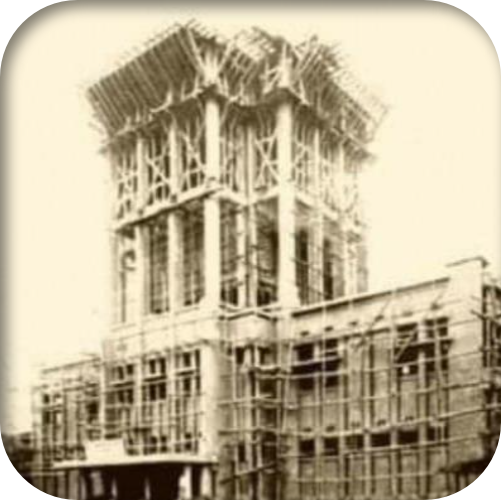City Hall or Watertoren as the First Modern Building in Palembang City Balai Kota (Raadhuis) Atau Kantor Ledeng (Watertoren) sebagai Bangunan Modern Pertama di Kota Palembang
Main Article Content
Abstract
This article discusses the use and function of raadhuis buildings, as well as water towers in Palembang City. This building has a multi-story structure with a concrete frame. The mayor of d'Armandville initiated the design of this building, a concept that Lissa Nessel, the subsequent mayor, carried forward. In this article, we will discuss buildings and non-buildings in the form of reinforced concrete from the construction of raadhuis and water tower buildings during that period, including notes on the development of the Palembang city hall complex, which has not been widely disclosed. Using archaeological and historical data, the aim of writing this article is to examine the development of the use, function, and expert design of this building complex, both during the colonial period and today. We conducted the research in four stages of archaeological-historical study: data collection, data analysis, data processing, and data writing. We cannot separate the results of the study of multi-story structures with concrete frames from the presence of the elite contractor Hollandsche Beton Maatschapij NV (HBM), based in Talang Jawa, Palembang. HBM was an early investor in the city of Palembang, which developed reinforced concrete as a structural material that was able to properly distribute construction loads evenly. So, architect S. Snuyf's design of Palembang City Hall can accommodate various structural elements. The presence of reinforced concrete from the Raadhuis construction triggered the construction of other reinforced concrete buildings in the city of Palembang.
Article Details

This work is licensed under a Creative Commons Attribution-NonCommercial-ShareAlike 4.0 International License.
References
Abubakar, A. (2020). Oedjan Mas di Bumi Sriwijaya: Bank Indonesia dan Heritage di Sumatra Selatan. Bank Indonesia Institute, Bank Indonesia.
Adliyah, N., Sukandar, S. C., & Marzuki, I. W. (2023). Anasir Eropa pada Bangunan Kubah di Kompleks Makam Lajangiru, Kota Makassar. WALENNAE: Jurnal Arkeologi Sulawesi Selatan Dan Tenggara, 21(2), 119–132.
Amici, C. M. (2023). Opus caementicium in Roman age: a Revolution in Building Technique. In Studies in Construction History (Vol. 1, pp. 3–13). Construction History Society.
Apriana, A., & Heryati, H. (2021). Perekonomian Masyarakat Sumatera Selatan abad 15-18 M. Danadyaksa Historica, 1(1), 1–11.
Arif, B., & Sukarma, R. (2015). Pengembangan air minum Indonesia dari masa ke masa, 1800-an-2009. Kementerian Pekerjaan Umum dan Perumahan Rakyat.
Asnan, G. (2015). Semen Padang dan Politik Ekonomi Kolonial. Jurnal Penelitian Sejarah Dan Budaya, 1(1), 51–61.
Becker, G. F. (1997). Art nouveau. Konemann.
Elliott, B., & Windover, M. (2019). The Routledge Companion to Art Deco. Routledge.
Elsen, J., Jackson, M. D., & Ruiz-Agudo, E. (2022). Historic Concrete Science: Opus Caementicium to “Natural Cements.” Elements: An International Magazine of Mineralogy, Geochemistry, and Petrology, 18(5), 301–307.
Hanum, N. N., Lukito, Y. N., & Kurniawan, K. R. (2020). Concrete: Politics in the Development of Modern Architecture in Indonesia. IOP Conference Series: Earth and Environmental Science, 452(1), 12009.
Hardianningrum, R. (2023). Adaptasi Fungsi Bangunan Kolonial Menjadi Rumah Kantor di Semarang. Scientica: Jurnal Ilmiah Sains Dan Teknologi, 1(1), 99–110.
Hens, A. M. (1909). Het grondbezit in Zuid-Sumatra. Korthuis.
Hermawan, I. (2022). Stasiun Kereta Api Cirebonn Prujakan dalam Tata Ruang Kota Cirebon Pada Masa Kolonial Belanda (1897-1942). WALENNAE: Jurnal Arkeologi Sulawesi Selatan Dan Tenggara, 20(1), 69–81.
Ilyasin, M. (2016). Epistemologi Pendidikan Islam Monokotomik: Menakar Manajemen Pendidikan Paripurna Berbasis Rasionalistik-Wahyuistik. At-Turas: Jurnal Studi Keislaman, 3(1).
Nugroho, W. O., Sagara, A., & Imran, I. (2022). The Evolution of Indonesian Seismic and Concrete Building Codes: From the Past to the Present. Structures, 41, 1092–1108.
Örmecioğlu, H. T. (2021). The Historic Concrete: Construction and Architecture. Engineering and Technology Management, 210.
Panggabean, S. M., Utari, S. A., & Roychansyah, M. S. (2020). Tipologi Bangunan Bekas Rumah Tinggal Tentara Kolonial Belanda di Kawasan Bintaran, Yogyakarta. Jurnal Lingkungan Binaan Indonesia, 9(1), 15–19.
Seprina, R. (2023). Perkembangan Kota Tua Palembang Masa Kolonialisme (1825-1942) sebagai Bahan Ajar di SMAN 3 Kota Jambi. Dewaruci: Jurnal Studi Sejarah Dan Pengajarannya, 2(2), 62–76.
Setyowati, M. (2019). Perkembangan Penggunaan Beton Bertulang di Indonesia Pada Masa Kolonial (1901-1942). Berkala Arkeologi, 39(2), 201–220.
Sures, M. A. (1966). Form Follows Function: The Architectural Theory of Louis Sullivan. Hunter College, Department of Art.
Tworzewski, P., Raczkiewicz, W., Czapik, P., & Tworzewska, J. (2021). Diagnostics of Concrete and Steel in Elements of an Historic Reinforced Concrete Structure. Materials, 14(2), 306.
Wellan, J. W. J. (1932). Zuid-Sumatra: economische overzicht van de gewesten Djambi, Palembang, de lampoengsche Districten en Benkoelen. (No Title).

